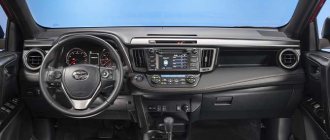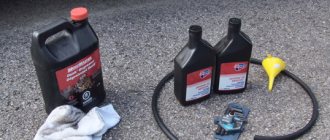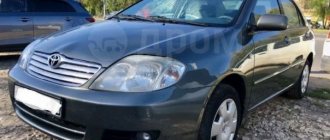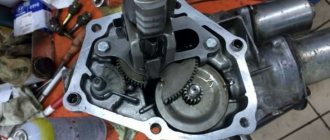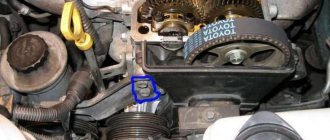Antifreeze is a liquid that removes excess heat during the operation of internal combustion engines, thereby preventing them from reaching critical overheating. It also prevents the cooling system from freezing in winter when the car is stationary. As a result of vehicle operation, antifreeze gradually loses its useful characteristics and requires periodic replacement. It is important to learn all aspects of choosing and replacing antifreeze in Toyota Corolla cars.
Coolants from different manufacturers differ in composition; in addition, they can be painted in different colors: red, blue, green, etc. As a rule, the color of the liquid does not depend on its composition, and each brand has its own color scheme. Most often, coloring is associated with convenience for the consumer:
- The colored liquid cannot be confused with a drink and should not be drunk.
- For each specific brand, the color is associated with the concentration of the active substance and the chemical type of base. By adding or filling in a compound of the same color from one manufacturer, you can avoid flushing the cooling system.
- Most manufacturers tint the coolant with fluorescent dyes, which allows you to quickly determine where it is leaking.
The only exception to this rule is propylene glycol-based products - they are most often colored red or pink. But the only sure way to determine the composition of a product is to read the label.
Properties of engine cooling fluids
During operation, the coolant heats up to 100 degrees and above, and when the car is parked, it cools down to ambient temperature. The efficiency of the cooling system and the durability of the power plant itself directly depend on the properties of antifreeze . Therefore, it must meet the following requirements:
- high heat capacity and thermal conductivity;
- mobility;
- low expansion coefficient and crystallization temperature;
- the product should not cause corrosion of metal surfaces, destroy rubber parts (seals and pipes) and foam during operation.
How does the fluid change procedure work?
Replacing antifreeze is carried out as follows:
- Place a container under the radiator to drain the waste.
- Wait until the engine cools down if the machine has been in working condition for a long time.
- Remove the cap from the expansion tank and open the heater tap.
- Unscrew the drain plug on the radiator and cylinder block.
- Wait until the waste drains completely.
- Tighten the drain plugs.
- Place a funnel in the filler hole and add fresh liquid.
Finally, you need to compress the inlet and outlet pipes. If the coolant level drops, you will need to add more. After this, you can screw on the cap of the expansion tank.
Now you need to start the Toyota Corolla engine and let it run for 5 minutes. Place the selector lever in position “P” on an automatic transmission or in the “Neutral” position if a manual transmission is installed. Press the gas pedal and bring the tachometer needle to 3000 rpm.
Repeat all steps 5 times. After this procedure, you need to check the anti-freeze level. If it drops again, you need to top it up.
Antifreeze classification
All existing coolants can be divided into three groups: basic, nitrate-free and silicate-free.
Depending on the base, they are also ethylene glycol and propylene glycol. Each of these groups is characterized by its individual composition and set of additives used. Most of them cannot be mixed, especially the silicate-free group: at best, the resulting mixture will have other properties that differ from the original ones; in the worst case, the antifreeze coagulates in the pipes of the cooling system and it will have to be flushed.
see also
- What kind of antifreeze to fill in Nissan Tiida
- Antifreeze g12 characteristics
- Is it possible to pour antifreeze into aluminum radiators?
- Replacing antifreeze Renault Sandero
- Daewoo Nexia coolant volume
- Antifreeze Siberia red g11
- Antifreeze for aluminum radiators based on ethylene glycol
- Mazda 626 coolant volume
- Antifreeze for games
- Checking the coolant temperature sensor VAZ 2110
- What should the coolant temperature be?
What antifreeze is recommended to fill a car in a Toyota Corolla?
Each automaker has its own requirements for the composition of the coolant, based on the characteristics of the cooling system. There are a large number of universal products suitable for different brands of cars. For Corolla, you can use different types of coolants produced on different bases; There is also no evidence that universal products lead to poor performance of their cooling system.
For optimal engine performance, the automaker recommends using silicate-free fluids with an organic corrosion inhibitor based on propylene glycol. This is due to the operating principle of the cooling system: a more viscous composition is optimal for forced injection of coolant. Original Toyota antifreezes meet these requirements:
- LongLifeCoolant (LLC) is a red liquid.
- Super Long Life Coolant (S LLC) - has a pink color.
Mixing pink and red products in the cooling system is not permissible, as this will make it necessary to flush the system.
Read about what kind of oil to put in a Corolla.
Choosing antifreeze for Corolla 150
The cooling system of the first Toyota Corolla 150 was filled with proprietary Long Life Coolant (LLC) antifreeze. Its article number is 0888980015, and the cost is 600-900 rubles. The coolant is red in color and is sold in concentrated form. It should be diluted with deionized water in a ratio of 50::60.
LLC for cars of early years of production
The use of distilled water to dilute the concentrate is prohibited. Many car owners note that with this mixing, sediment precipitates and flakes form. All this can lead to clogging of the cooling system circuit and cause the engine to overheat. For dilution, it is recommended to use Ravenol destilliertes Wasser with article number 4014835300514.
Most Toyota Corolla 150 vehicles use pink Super Long Life Coolant (SLLC) part number 0888980140. It is sold ready to fill. At the same time, official dealers recommend converting cars from LLC to SLLC, having first flushed the cooling circuit. The cost of pink liquid ranges from 800 to 3000 rubles.
Despite the fact that the manufacturer prohibits diluting SLLC antifreeze with water, many car owners claim that the coolant should still be diluted with water in a 50:50 ratio before filling. In this case, it is necessary to use exclusively deionized water, for example, Ravenol destilliertes Wasser.
It is prohibited to add distilled water or other antifreeze to Toyota Super Long Life Coolant. In most cases, this leads to the appearance of sediment and flakes, which significantly impair heat dissipation. However, do not mix original red and pink coolants. They are completely incompatible and undergo a violent chemical reaction.
At the same time, the automaker allows the use of antifreeze from third-party companies. Before filling them, the system must be thoroughly flushed. The best options for the Corolla 150 are shown in the table below.
Table - Antifreeze for Corolla 150 from third-party manufacturers
ManufacturerArticle numberApproximate cost, ruble
| General Motors | 1940663 | 250-310 |
| Opel | 1940663 | 450-520 |
| Ford | 1336797 | 380-470 |
If, after pouring in fresh antifreeze, its color quickly changes to brown, this means that it does not contain the required amount of corrosion inhibitors. With a high degree of probability, this fluid is counterfeit, so it should be replaced as soon as possible.
In what cases should antifreeze be replaced?
There is a planned replacement of antifreeze, caused by the gradual destruction of the additives included in its composition. As a result, the product begins to foam, the heat exchange process in the engine deteriorates, which can lead to overheating. Also, due to changes in the set of additives, parts in contact with the liquid may be destroyed.
On the packaging of each product there is information about its service life. This is what you should primarily be guided by when drawing up a replacement schedule. If, due to various factors, rapid “aging” of the coolant is observed, then replacement is carried out ahead of schedule.
The main signs that the composition has become unusable:
- a jelly-like mass appears on the surface of the expansion tank;
- in mild frosts, the contents of the expansion tank turn into a mushy state, or some sediment appears in it;
- frequent operation of the cooling system fan;
- contamination of the contents with foreign substances is visually noticeable;
- in case of an emergency, for example, if a hose burst on the road and you had to add water to the system.
replacement, how much to fill, what coolant to choose
7098 Apr 20
To prevent overheating of the engine while the engine is running, as well as to prevent freezing of the fuel supply system in winter, a liquid such as antifreeze is used in cars. Replacing antifreeze in a Toyota Corolla 150 body, as well as in other models of this brand, has some features. This applies to the choice of coolant, in which certain rules must be followed to ensure efficient operation of the unit.
Why is antifreeze needed?
Coolant simultaneously performs several quite important functions:
- Provides engine cooling, preventing it from overheating;
- in automatic transmissions it helps cool the hydraulic fluid;
- works as a lubricant for the engine water pump;
- participates in the processes of heat generation during the cold season.
Replacing antifreeze with your own hands
Replacing coolant in a Toyota Corolla is not particularly difficult and does not require the use of special tools. If necessary, this work can be easily done with your own hands, without going to a service station.
Step-by-step replacement:
- Place a pan or other container under the radiator and engine to drain the fluid;
- if necessary, wait for the engine to cool completely;
- remove the expansion tank cap;
- open the stove tap to maximum;
- unscrew the drain plugs on the cylinder block and radiator and wait until the contents have completely drained;
- screw in the plugs and tighten them with the required force;
- gradually pour new antifreeze into the expansion tank to the maximum level mark;
- Squeeze the radiator outlet and inlet pipes several times, and if the fluid level drops after this, add it to the required level;
- Reinstall the cap and valve onto the expansion tank.
After replacement, start and warm up the engine so that the thermostat opens and let the car run for 5-10 minutes. Press the gas pedal so that the revolutions rise to 3000, and keep the car in this mode for 1 minute. After this, the engine should idle for 30 seconds. This operation should be repeated 3-5 times so that the new composition is evenly distributed inside the cooling system.
After the engine has cooled, check the antifreeze level in the tank again and add it if necessary.
Changing the oil in a Toyota Corolla engine.
The user said thank you:
Message from Yuri Altman
So, tell me how to get rid of air jams?
Do they really exist? Within 20 minutes of engine operation with improper coolant circulation, the temperature would rise significantly. After replacing the pump, as far as I remember, I didn’t have to add almost anything. I filled it into the expansion tank immediately after replacing it and the level remained the same.
The radiator does not warm up, which means the antifreeze does not circulate in a large circle, it should warm up in 20 minutes
Good day, Comrades! I bought pink antifreeze for refilling from OD. After 2 weeks, flakes formed at the bottom. Do you think this is counterfeit?
If the temperature under load rises above normal, then yes, the coolant does not circulate in a large circle. And so, it is quite likely that there is no problem as such.
Instructions for removing air are in the technical document:
d.Remove the radiator cap and add coolant up to line B of the expansion tank. e.Squeeze the radiator inlet and outlet pipes with your hand several times, and then check the coolant level. If the coolant level is insufficient, add coolant. f.Install the cap and valve and warm up the engine. g.Bleed the cooling system.
NOTE:•Before starting the engine, turn off the air conditioning system.
•Set the air conditioner temperature to MAX (HOT).
•Set the air conditioner fan control knob to the Lo level.
i.Warm the engine until the thermostat opens. When the thermostat opens, allow coolant to circulate for a few minutes.
HINT: The thermostat opening time can be checked by squeezing the radiator inlet pipe with your hand and making sure that coolant flows into the hose.
ii. After warming up the engine, run it for at least 7 minutes with the following cycles: at 3000 rpm for 5 seconds, idling for 45 seconds (repeat this cycle at least 8 times).
iii.Squeeze the radiator inlet and outlet pipes with your hand several times to remove air from the system.
Message from Ivan-Ivan
Good day, Comrades! I bought pink antifreeze for refilling from OD. After 2 weeks, flakes formed at the bottom. Do you think this is counterfeit?
A 2-year-old car should not require topping up. Apparently, the antifreeze is leaking somewhere, perhaps the pump is leaking. It was necessary to kick the officials while the car was under warranty in order to find the cause of the leak. Perhaps they sold the wrong type of coolant. There should be no sediment even after many years.
Safety precautions when replacing engine cooling fluid
When replacing the coolant yourself, you should take the following precautions:
- Do not unscrew the expansion tank cap when the engine is hot, as this may cause burns due to the release of steam or liquid.
- If the composition gets on the body or in the eyes, rinse them as quickly as possible with a large volume of cold water.
- When squeezing the rubber pipes of the cooling system, you need to be careful, as they can be hot - use gloves when performing this work.
- When replacing or topping up, use the same composition that was filled in earlier; when choosing Toyota fluids, do not mix red and pink products. Otherwise, flush the cooling system before filling.
Replacement procedure
If you switch to a new type of antifreeze or if it is impossible to determine what is in the system, experts recommend flushing. To do this, place the car on a level surface and prepare:
- container for waste liquid;
- funnel for filling;
- distilled water at the rate of 6-8 liters per wash.
Then drain the coolant.
- Unscrew the expansion tank cap and the filler cap on the radiator.
- After this, put a hose with a diameter of at least 8 mm onto the drain fitting located at the bottom of the radiator, unscrew the fitting and drain the coolant.
- There is a coolant drain plug located near the oil filter in the engine block.
- Unscrew the drain plug with a 14 mm wrench, first placing a container for technical fluid. Fill flushing fluid through the filler hole on the radiator. The fluid level should correspond to the Full mark on the expansion tank. Based on the color of the drained liquid, be guided by the number of cycles; check the volume of antifreeze in the Toyota Corolla.
- After filling in the flushing fluid, start the engine.


